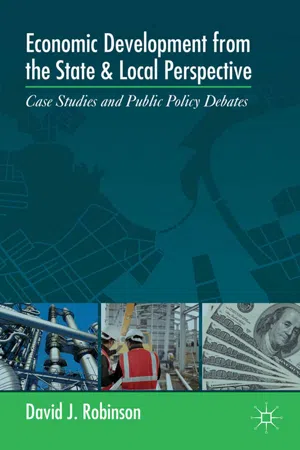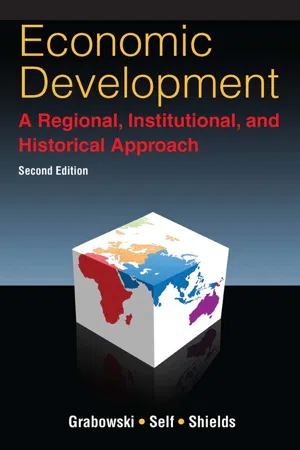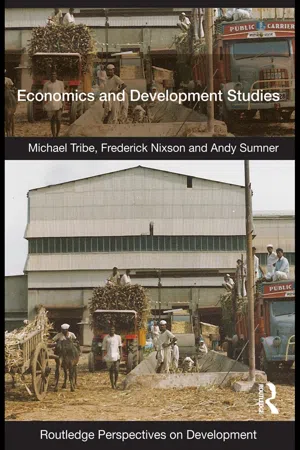Economic Development
Economic development refers to the sustained, concerted actions of policymakers and communities that promote the standard of living and economic health of a specific area. It involves improving various aspects of the economy, such as infrastructure, education, healthcare, and technology, to create a more prosperous and equitable society.
8 Key excerpts on "Economic Development"
- eBook - ePub
- Miranda Thurston(Author)
- 2014(Publication Date)
- Routledge(Publisher)
...ECONOMIC AND HUMAN DEVELOPMENT DOI: 10.4324/9781315770109-9 Context The concept of ‘development’ has historically (and somewhat ambiguously) been used to refer to some form of social progress, transition or advancement in a country. Yet the conventional orthodoxy has been to discuss a country’s level of development in economic terms. In recent years, however, the UN has been influential in promoting a broader view of development based on human (abilities, skills, knowledge and other capabilities) as well as economic capital. According to the UN, human development represents progress in terms of the extent to which a country provides people with choices and freedoms, including those relating to their health and welfare. This broader view of development reflects a growing appreciation of the complex relationship between economic growth, human development, and population health. The 18 MDGs (adopted by 189 nations during the UN Millennium Summit in September 2000) reflect this interdependence by focusing efforts on goals that relate to fundamental development domains, such as poverty reduction, literacy, reproductive choices and so forth. Defining economic and human development Economic Development has traditionally been strongly linked with economic growth, which has been the predominant marker for tracking a country’s advancement. The term refers to qualitative shifts in a country’s economy towards increases in economic productivity. The conventional specific indicator of Economic Development has been gross domestic product (GDP), defined as the market value of all goods and services produced within a country in a given period of time. GDP per capita (person) has often been used as an indicator of the standard of living in a country...
- eBook - ePub
Economy/Society
Markets, Meanings, and Social Structure
- Bruce G. Carruthers, Sarah Louise Babb(Authors)
- 2012(Publication Date)
- SAGE Publications, Inc(Publisher)
...More recently, however, economists’ advice to developing countries has become more diverse and more open to considering the nonmarket foundations of development. This chapter is divided into three sections. The first examines how Economic Development should be defined. The second section looks at some of the advice that economists have given to developing countries since the founding of their discipline—and the ways that governments have followed and ignored that advice. Finally, the third section looks at sociological contributions to development debates. Economic Development Defined If you have traveled back and forth between the developed and the developing world, you have an intuitive understanding of what Economic Development means—you know it when you see it. In reality, however, the meaning of Economic Development is more difficult to pin down than it appears. Development, the process of improving people’s lives over time, is a fundamentally relative concept, in the sense that what counts as “developed” changes over time. One of the problems of underdeveloped countries is that they have no fixed point of development to catch up to: As countries such as the United States continue to grow and become more technologically sophisticated, countries such as Mexico are in danger of falling increasingly far behind. Development is also a complex and contested concept, in the sense that there are different views about the best way to define and measure it. A half century ago, development experts agreed that development was best defined by national income per capita—that is, the total value of the goods and services produced by a nation over a period of time divided by the number of people. This is no longer the case, for reasons we will examine shortly...
- eBook - ePub
Environmental and Natural Resources Economics
Theory, Policy, and the Sustainable Society
- Steven Hackett, Sahan T. M. Dissanayake(Authors)
- 2014(Publication Date)
- Routledge(Publisher)
...We will then consider several competing theories of sustainable development and how particular indicators of sustainable development have been derived from these theories. We will conclude with several brief case studies that measure progress relative to various sustainable development standards. Economic Development Seeks to promote job formation and improvement in the material standard of living by fostering an environment conducive to business formation, retention, and expansion. Policies may include workforce training, infrastructure investment, and effective planning and permitting. Conventional Economic Development Strategies The primary goal of conventional international Economic Development assistance has been to increase GDP and the material standard of living in lower-income countries. Increases in real per-capita income have been a prized objective of development policymakers because rising incomes can lift people out of poverty and provide them with access to medicines, safe drinking water, and cleaner production technologies. Moreover, income can be relatively objectively measured, and so analysts can gauge the success of development policies and programs with objective performance data. As we shall see, in the post-World War II period, international development assistance programs were modeled on the reconstruction of developed European countries and focused on large project-based lending designed to increase per capita incomes. Unintended consequences of these Economic Development programs have led to the movement for sustainable Economic Development. Conventional Economic Development Assistance Programs International Economic Development policies take the form of technical assistance, financial assistance, and development loans...
- Eckhard Siggel(Author)
- 2016(Publication Date)
- Routledge(Publisher)
...Economic Development can therefore also be described as a process of growth and structural change, where the latter may refer to changes in the sector composition or to other structural effects. High average income, even if distributed in a socially acceptable way, is not a guarantee for the fulfilment of human needs in areas such as education, health care, longevity, or personal freedom. It has therefore become standard practice to define Economic Development by reference to sets of indicators measuring these aspects. The Human Development Index, computed and published annually since 1990 by the UNDP, is a composite indicator of several welfare aspects including education, health, and per person income. It is the subject of the first case study, where it is explained in some detail. The concept of national income as measured in the national accounts is not a perfect measure of material well-being, nor of the level of production, because it fails to include various forms of income that are either not marketed or unrecorded, such as the value of housework, child raising and various activities associated with subsistence agriculture and the informal sector. The level of subsistence and informal sector activities is usually estimated by national statistics bureaus and added on to the national accounts, but many other activities, in particular female work in the household, are not included in the concepts of domestic production and income. This is a shortcoming from the point of view of trying to measure all economic activity, but it is widely accepted because of the difficulty of measuring other activities. In spite of these limitations, the average or per capita level of income is often used as a broad indicator of the level of development. The reason for this usage is threefold: data availability, relative comparability of this measure across countries, and a strong correlation with other indicators of well-being...
- eBook - ePub
Economic Development from the State and Local Perspective
Case Studies and Public Policy Debates
- D. Robinson(Author)
- 2014(Publication Date)
- Palgrave Macmillan(Publisher)
...Economic Development is a public good because it creates the wealth people need to live. The more economic success individuals have, the larger the private market and government tax revenues grow to provide the resources everyone needs to succeed. Local and state governments take the lead in the retention and attraction of jobs and companies. The federal government defines the legal and constitutional powers of government to regulate private industry and implements monetary, fiscal, trade, labor, and other laws at the national level. It funds a range of programs used by local and state governments and private sector companies to foster Economic Development. It adopts broad full employment goals but does not mandate a national economic plan. Instead, a federalist approach dominates where local and state governments take the lead in implementing Economic Development strategies. Economic Development versus Real Estate Development versus Community Development Economic Development differs from real estate development and community development. Economic Development creates a higher standard of living for its residents. Its focus on retaining and attracting higher-wage jobs and developing companies provides a stronger tax base for local government and schools. These essential public services help develop a world-class quality of life. Economic Development differs from real estate development and traditional notions of community development. At times they all overlap, but at their core the goals of each are different. Economic Development involves the use of public subsidies to incentivize private sector wealth creation. Real estate development is the “continual reconfiguration of the built environment to meet society’s needs.” 13 It may or may not create high-wage jobs. Real estate development improves a parcel of land to increase its value. Real estate developers turn a cornfield into a housing project or an abandoned factory into a shopping center...
- Andrew Beer, Terry L. Clower(Authors)
- 2019(Publication Date)
- Routledge(Publisher)
...development; • The broad principles applied to Economic Development practice in one city, region or community can be transferred to others, and this has been reflected in the spread of critical concepts and thinking at the global scale; • There are a number of relevant academic associations that offer access to the latest thinking on the topic and substantial research resources; and, • The context within which the profession of Economic Development is practiced shapes the day-to-day activities of practitioners and the delivery of programs to communities and businesses. Discussion questions As individuals and in groups, think about the types of jobs that might attract you to the Economic Development profession. Give thought to: a) the type of community you may wish to work in (rural, small metro area, a commuter city, or major urban area); and b) the type of employer/activity you are likely to find attractive (site selection firm, city planning department, chamber of commerce, local Economic Development authority, community development department). As a class, discuss the strategies and activities you will use to facilitate the development of your careers (e.g. further education, relocation to opportunities, professional affiliations and memberships). References American Planning Association (APA) 2018 Available at https://www.planning.org/. Beer, A., Ayres, S., Clower, T., Faller, F., Sancino, A. and Sotarauta, M. 2019 Place leadership and regional Economic Development: a framework for cross-regional analysis, Regional Studies, 53:2, pp 171–182. Beer, A., Haughton, G. and Maude, A. 2003 Developing Locally: Lessons in Economic Development from Four Nations, Policy Press, Bristol. Blakely, E. 1994 Planning Local Economic Development: Theory and Practice, Sage Publications, Thousand Oaks, CA. Currid-Halkett, E. and Stolarick, K...
- eBook - ePub
Economic Development: A Regional, Institutional, and Historical Approach
A Regional, Institutional and Historical Approach
- Richard Grabowski, Sharmistha Self, William Shields(Authors)
- 2014(Publication Date)
- Routledge(Publisher)
...When Kuznets talked about modern economic growth, he was referring to the first three characteristics of development mentioned here. The latter two were added by economists such as T.W. Schultz (1962) and Dudley Seers (1969). Shultz introduced the concept of human capital as a necessary ingredient for growth. This introduced education and training as important prerequisites for growth. According to Seers, development was a social phenomenon that involved more than growth in per capita output. Seers believed that development meant the elimination of poverty, unemployment, and inequality. This led to a review of structural issues such as education, health care, population growth, urbanization, and agricultural reform on their own merits. Commonly Used Measures of Development As mentioned above, Economic Development was traditionally equated with economic growth, which is typically measured by per-capita GDP. GDP is the market value of all final goods and services produced in an economy in a year. However, given the acceptance of Economic Development as an independent concept, different variables and indexes have been used by economists to define and measure development. Economic Development is a broad and inclusive term; it is easily conceptualized but difficult to measure or quantify. In addition to per-capita GDP, economists have traditionally used a measure of health (life expectancy, infant mortality, incidence of disease, number of HIV/AIDS cases, and immunization rates) or education (enrollment rates, average years of education, youth or adult literacy rate) or other economic conditions (poverty rate, inequality of income distribution, child labor, unemployment rate) as a proxy for development. Some research institutions have recently developed indexes to serve as more inclusive measures of development. The World Bank introduced the idea of “redistribution with growth” (RWG)...
- eBook - ePub
- Michael Tribe, Frederick Nixson, Andy Sumner(Authors)
- 2010(Publication Date)
- Routledge(Publisher)
...This is the central problem because the central fact of Economic Development is rapid capital accumulation (including knowledge and skills with capital). We cannot explain any ‘industrial’ revolution (as the economic historians pretend to do) until we can explain why saving increased relatively to national income. (Lewis, 1954: 155) Many serious students of international development studies might ask why economic growth is considered to be so important. At a time in global development when many would question the justification for an emphasis on economic growth on environmental grounds, it should be clear that if the Millennium Development Goals (MDGs – United Nations, 2009a) are to be achieved to an acceptable degree, then economic growth is a necessary, but not a sufficient, condition. In other words, the achievement of higher standards of living across society as a whole requires economic growth. This implies that development studies specialists concerned with the welfare objectives embodied in the MDGs need to be aware of the economic factors associated with economic growth. A controversial but influential contribution to the discourse relating to poverty reduction is that of Dollar and Kraay (2002; 2004). However, their ‘Growth is Good for the Poor’ suffered from a number of shortcomings, notably the absence of a rigorous definition of poverty (‘the poor’) and of a clear methodological distinction between cross-section and time-series analysis (Amann et al., 2006). Despite the heated controversy generated by the Dollar and Kraay paper, the logical connection between economic growth and poverty reduction – both absolute and relative – would not be disputed by most economists. The definition of poverty, and of ‘the poor’, is explored systematically in Chapter 9 of this book. The significance of the distinction between ‘cross-section’ and ‘time-series’ analysis requires a little more clarification...







